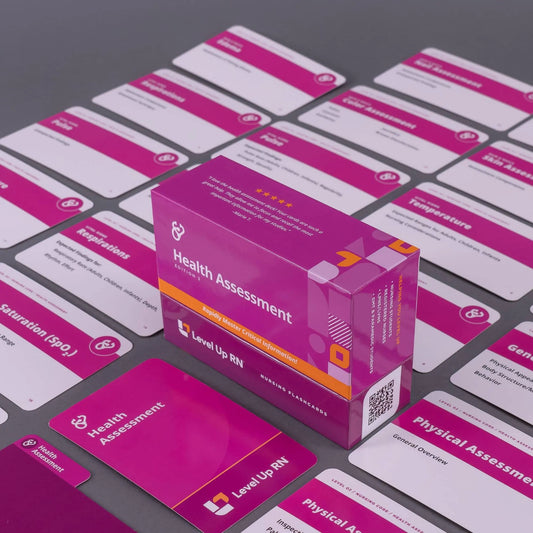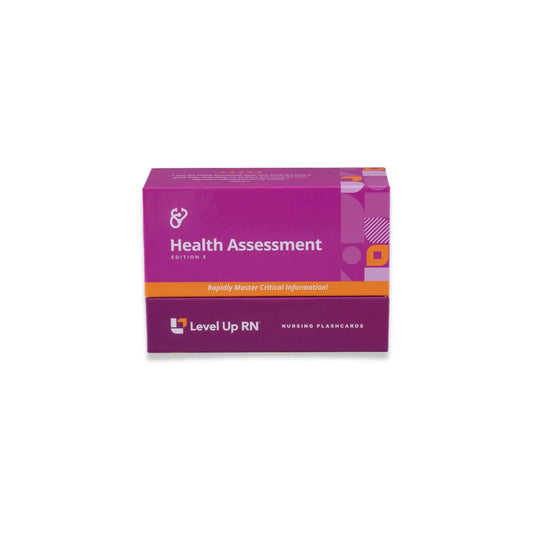Hi, I'm Meris, and in this video, I'm going to be covering different types of skin lesions, both primary and secondary. I'm going to be following along using our health assessment flashcards. These are available on our website, leveluprn.com, if you want to grab your own. And if you already have them, I would invite you to pull them out and follow along with me. All right. Let's get started.
So first up, we're going to be talking about primary skin lesions. And now, when we're talking about primary versus secondary, primary skin lesions are those that develop directly from previously healthy skin. And they could be present at birth, they could be developed later, but they arise on their own.
Whereas secondary skin lesions are going to arise from primary skin lesions or as a direct result of some sort of action taken by the patient like rubbing or itching, those sorts of things that can exacerbate or irritate the skin.
So we're talking about primary lesions. So first up, let's talk about how we're going to categorize these. So here on this card, we have it broken down for you in a few different ways. So we're going to talk about flat areas of discoloration, meaning flush with the skin or mostly flush, elevated solid lesions, meaning that they are elevated from the skin, but they are solid, elevated fluid filled lesions, elevated from the skin, but filled with fluid. And then we'll talk about just other abnormal tissue growth.
So first off, flat area of discoloration, we call it a macule if it is less than one centimeter, such as a freckle. And then we call it a patch if it is greater than one centimeter, such as a birthmark. So that's how we would differentiate between those two.
Now, elevated solid lesions, okay, again, remember solid. So when we feel it, it's going to feel solid. It's not going to feel like there's fluid inside it.
A papule is less than one centimeter, so that's going to be a mole. So if you see here, I have this little mole on my skin. It's not a freckle. It's been present since birth. It's always there. It never goes away. It is slightly elevated. So if you run your finger over it, you can feel it. However, it's small. It's less than one centimeter, so we would call that a papule.
A plaque is going to be greater than one centimeter, and for instance that could come from psoriasis.
And then a wheal, W-H-E-A-L, a wheal, is going to be this idea of a superficial, irregularly shaped, transient, raised, lesion. And this is very commonly associated with allergies. So thinking of a hive, right? Or if I have an insect bite me, and then I get that weird, funky lesion on my skin. We call that a wheal. So that is elevated solid lesions.
Now, elevated fluid filled lesions, we're talking about vesicles. Vesicles are elevated. They are serous filled, so filled with serous fluid, and then they're going to be less than one centimeter in diameter. For instance, this might be present with a patient who has chickenpox.
Now, a pustule is a pus filled vesicle. So same idea, it's elevated, it is fluid filled, but rather than being filled with serous fluid, it is filled with pus. It is purulent. And again, that's going to be less than one centimeter. An example of a pustule would be a lesion associated with acne, okay. So that's a pustule. It's not serous fluid, it's pus.
And then a bulla. A bulla is elevated. It's cirrus filled, but it's greater than one centimeter. And so an example of this would be a blister. So if I went and I wore my shoes all day, and I got a blister like this on the back of my heel, that's a bulla.
We do have a nice cool chicken hint here to help you remember this. Vesicles are very small. Pustules are pus filled, and it's a big old bulla. So we actually have it the other way. Vesicles are very small compared to a big old bulla, but a pustule is pus filled. So that way you can remember the size associated with these things.
And then lastly, abnormal tissue growth. So an example here would be a nodule. It's firm. It's going to be deep in the skin, maybe one to two centimeters in diameter. An example of this would be a lipoma, which is kind of a lesion. It's like a fat filled lesion. It's in the subcutaneous region, and that would be an example of a nodule.
Now, a tumor is a solid mass that is deep and is greater than two centimeters in diameter. And an example of this would be what we all think of, like a neoplasm, a malignant neoplasm, meaning a cancerous tumor. So if a patient says that they had a tumor in their breast that they had removed, that's a tumor. It's larger than two centimeters. All right.
Now, moving on to secondary lesions. We have a very nice table here for you. Again, I'm not going to review every single word on this card, just hit the highlights. But if you want the in depth information, it is available in the cards. A crust is just any sort of a thickened, dried exudate. So for instance, pus or serous fluid. So a great example is impetigo, has those sort of honey crusted lesions around the mouth typically, but any sort of crust. If I scratch a bug bite and that serous fluid comes out, it's going to form a crust. That's why it's a secondary lesion because it's caused by me scratching, for instance.
Scale. Scale is the white and silver flakes of skin that is typically associated with psoriasis or eczema. And remember, we said psoriasis can cause plaques, which are primary lesions. And if that plaque gets irritated or disturbed, then it can lead to scale. A fissure is any sort of a crack in the skin. So I always think of fissures as being like deep cracks in the heels of a patient. You'll see those patients with those deep, really-- they have those thick calluses on their heels, and they've got big lines running throughout them. And those are called fissures.
Erosion. So erosion is a shallow depression involving just the epidermis. And an example would be if I had a bulla, if I had a blister, right, and it ruptured, and that skin got pulled off the top, I would be left with an erosion. That's why it's secondary.
An ulcer is any sort of a deep depression that extends into the dermis, and there's lots of reasons that we could have an ulcer of the skin.
A keloid. A keloid is an overgrowth or hypertrophy of scar tissue. It's an abnormal growth of scar tissue. So for instance, I have a scar here on my neck. It's nice and flat. It just looks like an old scar. However, if I had a keloid, it would be kind of thick and rubbery, and it would be elevated and could look like that scar tissue is overgrown.
And then atrophy. Atrophy is any sort of thinning or wearing away. So skin atrophy could be associated with the thinning of the epidermis. And an example here would be stretch marks, which we call striae. So if I have striae gravidarum associated with pregnancy, I'm going to see those stretch marks. But what's actually happening there is that the epidermis has thinned in those areas. So we would call that then atrophy.
All right. That is it for this video. Be sure to stay because I've got some quiz questions to test your knowledge of key facts I provided in this video.
How should the nurse document a superficial, raised, irregular shaped lesion present on the patient's skin following an insect bite?
That is a wheal.
The nurse is caring for a patient who reports having a history of keloids. How can this finding be best described?
Hypertrophy or overgrowth of scar tissue.
How should the nurse document freckles present on a patient's face? These are macules.
What is the difference between a vesicle and a bulla? Vesicles are smaller, less than one centimeter, while bulla is bigger, greater than one centimeter. All right.
Be sure to catch the next video where we will be talking about some important components of nail assessment. You're doing a really great job, and I'm super proud of you. Thanks for studying with me.


